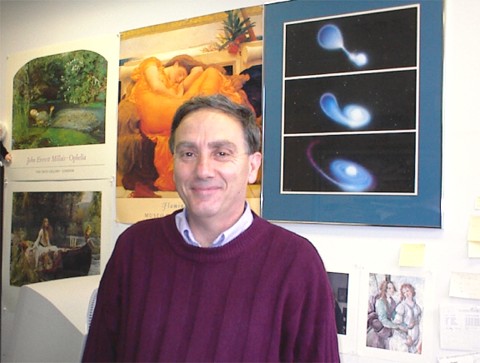This is what Prof. Mario Livio, a senior at the Space Telescope Institute in Maryland, tells the science website. Planetary/Wide-Field Camera #3 is now taking the deepest picture of space yet, he said.

Yesterday we saw a first example to the new capability of the Hubble Space Telescope and in particular to the Planetary Camera/Wide Field Camera No. 3 which replaced the Camera No. 2 installed on Hubble in 1993. At the press conference organized by the heads of the Space Telescope Science Institute, held in Washington, they presented many such images of all the telescope's instruments .
The press conference was organized by Prof. Mario Livio, who until about a decade ago served as a senior lecturer and researcher at the Physics Faculty at the Technion. In a conversation with the science website he says that the grief works great, in fact maybe better than ever. All the instruments are working, even the NIKMOS camera, the only device on the Hubble that was not replaced or repaired in the servicing mission that took place in May, has been brought back to life, and is now in the stages of acceptance tests.
The hottest images were those transmitted by Planetary Camera No. 3, which has a wider spectrum range than ever before - from ultraviolet through visible light to infrared, when it is amplified by a camera that is still working, but was insensitive and had a limited field of view. According to Prof. Livio, that dedicated camera still has a number of roles left, "and it's good that we were able to bring it back to life, but the main role of photographing the universe in infrared falls on the planetary camera.
"As we speak, camera #3 continues to take the deepest picture of the universe, a project we started a few days ago. Soon we may be able to publish this image.
Another device that works great is the Cosmic origin spectrograph that works great. We showed a number of pictures he took, it's a completely different world - it has a sensitivity about 10 times higher than the previous spectrograph, especially in the ultraviolet light. We hope to use it to discover the entire structure of the intergalactic medium - all the gas between galaxies that cannot be seen. We look at a very distant light source like a quasar and when the light passes from the quasar to us it is swallowed up along the way by all kinds of clouds of the intergalactic medium. We see these absorptions and can determine the structure of the intergalactic medium.
According to Livio, in addition to the two new devices, the astronauts repaired two existing devices: the Advance Camera for Surveys and a spectrograph. The advanced survey camera was the workhorse of the telescope and it still works exceptionally well as we also showed yesterday. At the press conference we published a picture she took of a galaxy cluster that forms a gravitational lens. Gravity bends the light and creates enlarged but distorted images of galaxies that are behind the cluster, we showed an impressive image of this from the previous camera. All the instruments now on the telescope are working, in fact we have the largest collection of working instruments ever on the telescope, you can think of this as the beginning of the telescope's new life.
How did the public receive the messages?
"Yesterday these photos were a hit all over the media, when I looked during the press conference, right after we were already in 156 places almost immediately. Today, of course, there are reviews in the New York Times and the Washington Post. What happened has nothing to do with us - there was a very important speech by the president on the health system, of course starting in the evening it grabbed all the headlines. If it hadn't happened on the same day the president was speaking, we might have been on the front pages everywhere. The Washington Post still has a picture on the front page and a big article on page 3. That's fine.”
What do you think of the interim report of the NASA review committee? Is it realistic to add 3 billion dollars to the NASA budget?
What was published this week is only a summary We are waiting for the full report of the Augustine Committee to be published, where it is mainly about what is happening in terms of the decision on priorities between manned or unmanned flights, this will be one of the main points that this report will say what it thinks. In the current situation there is not much money, the economy has not recovered. I think it will be difficult to add budgets to NASA, but we will wait and see, maybe the economy will recover in the meantime.

5 תגובות
Mario will come back to Israel, we miss you!
Can't wait for the pictures!!!